By Phil Newman – CEO & Founder Longevity.Technology –
Leopoldina issues policy paper urging integration of geroscience into national healthcare and research infrastructure.
Germany’s National Academy of Sciences Leopoldina urges a major shift in healthcare: treat aging as the main driver of chronic disease, not just background risk. Its new paper calls for systems built around aging biology, with preventive geromedicine leading efforts to reduce multimorbidity.
Titled Health-Extending Medicine in an Aging Society, the paper draws on experts from Europe, the US and Asia. It recommends biobanks, aging biomarkers, and scalable interventions — responding to “the imminent challenge” of a society where one in three Germans will be over 65 by 2035.
Germany’s National Academy of Sciences calls for aging biology to become the foundation of healthcare, moving geroprotective medicine from the margins to policy. Aging, they argue, must be treated directly to address the rising burden of age-related disease.
This is a push for urgent, system-wide change – from clinical trials and biomarker use to regulatory reform and clinician training. If Germany leads, it could extend healthspan for millions and set a global example.
Dr Andrea B. Maier , who co-authored the paper and holds the Oon Chiew Seng Professorship in Medicine at the National University of Singapore , welcomed the publication, stating: “Today, the German National Academy of Sciences Leopoldina published a powerful discussion paper calling for medicine to address ageing itself, rather than waiting to treat age-related diseases like cancer, dementia, or cardiovascular disease.
Dive deeper into how top scientists are reshaping healthcare by putting aging biology and preventive geromedicine at the center of disease prevention right HERE. Plus, explore how Parallel Bio plans to transform drug discovery timelines and costs with a bold new approach and finally, read how Ireland is shaping the future of longevity, with key insights from Longevity Summit Dublin CEO Martin O ‘Dea




